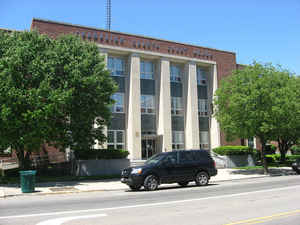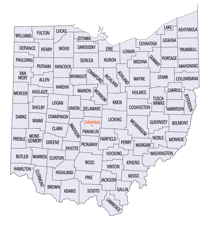Ohio Counties
There is eighty-eight counties in the state of Ohio. Washington County the oldest in the state established on July 27, 1788. Noble County was formed on March 11, 1851 from portions of Guernsey, Morgan, Monroe and Washington counties. It was the last county to be formed in Ohio and, therefore, represents the youngest county in the state.Champaign County, Ohio
Champaign County Education, Geography, and History
Champaign County is a county located in the state of Ohio. Based on the 2010 census, the population was 40,097. Its county seat is
Urbana. The county takes its name from the French word for "open level country".
Champaign County comprises the Urbana, OH Micropolitan Statistical Area, which is also included in the Dayton-Springfield-Sidney, OH Combined
Statistical Area.
Etymology - Origin of Champaign County Name
The county's name came from the French word for "level land."
Demographics:
County QuickFacts: CensusBureau Quick Facts
Champaign County History
On February 20, 1805, the Ohio government authorized the creation of Champaign County. The county's name came from the French word for "level land."The county was originally parts of Greene and Franklin Counties. Among the county's earlier residents were the Swedenborgians, a religious group
that established Urbana University.
Champaign County is located in west central Ohio. It is predominantly rural, with less than one percent of the county's 429 square miles consisting of urban areas. The county seat is Urbana. With a population of 11,613 people, Urbana was the county's largest community in 2000. Unlike most of Ohio's
predominantly rural counties, Champaign County experienced an eight percent population growth rate between 1990 and 2000, bring the total number of residents up to 38,890. The county averages ninety people per square mile.
The largest employers in Champaign County are manufacturing businesses, followed closely by farming. Service industries, sales positions, and government are close behind the primary two employers. In 1999, the per capita income in the county was almost twenty-four thousand dollars, with 7.5 percent
of the people living in poverty.
Most voters in Champaign County claim to be independents, yet in recent years, they have supported Republican Party candidates at the national level.
Among Champaign County's more prominent residents was backwoodsmen Simon Kenton, who is buried in Urbana's Oakdale Cemetery. John Quincy Adams Ward, a famous sculptor, was born in Urbana, as was Brand Whitlock, a novelist, Progressive, and eventual mayor of Toledo, Ohio.
Sources
Champaign County, Ohio History Central, July 23, 2008,
http://www.ohiohistorycentral.org/entry.php?rec=1910&nm=Champaign-County
Geography: Land and Water
As reported by the Census Bureau, the county has a total area of 430 square miles (1,100 km2), of which 429 square miles (1,110 km2) is land and 1.2 square miles (3.1 km2) (0.3%) is water
Neighboring Counties
Bordering counties are as follows:
- Logan County (north)
- Union County (northeast)
- Madison County (southeast)
- Clark County (south)
- Miami County (southwest)
- Shelby County (northwest)
Education







